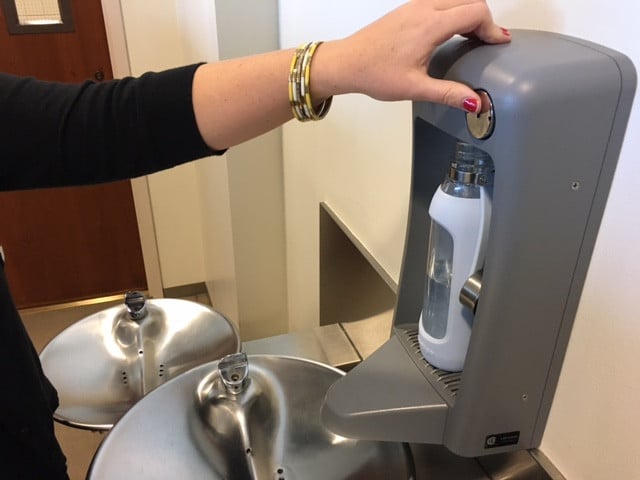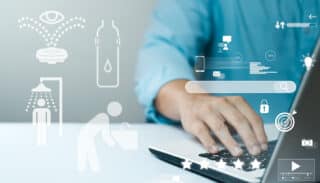OAKLAND, CALIFORNIA — The East Bay Municipal Utility District laid out plans Tuesday for a pilot program to open seven water fill stations to promote tap water use and reduce use of disposable plastic water bottles.
If the stations prove popular, the water district would consider opening more of them within its territory in Contra Costa and Alameda counties.

The vertical design of the proposed EBMUD water stations make it easy to fill up water bottles. (Denis Cuff)
Unlike traditional water fountains that bubble water upward, the hydration stations dispense water downward to quickly and conveniently fill up water bottles, which can be carried to work and school or on runs and hikes. Fountain angles often make it difficult to fill a bottle.
“The idea is to get people to drink more tap water and produce less plastic trash,” said Marguerite Young, an EBMUD board member from Oakland. “We have very high quality water, and drinking tap water costs a small fraction of purchased bottled water.”
Young and two others on the board’s sustainability and energy committee informally supported the plan Tuesday. The committee told district managers to work out details of the program and line up sites at schools, parks and transit stations.
EBMUD officials said they would like to install a fill station at up to three BART train stations because they believe it would be popular, providing a good test of the program.
While many airports have bottled water fill stations located past security checkpoints, BART has none in its sites. BART bans drinking water or other liquids on train cars to help keep them clean.
BART spokesman Jim Allison said the train system hasn’t had time to study the proposal and take a position on it.
Water district officials estimate it would cost $70,000 to $160,000 to establish seven stations. Estimates vary sharply because a station would cost much more if the site didn’t already have water pipes.
Bottled water companies say their product is popular because it’s convenient to use.
Water district staffers said promoting tap water use is an environmentally friendlier alternative to having people use bottled water.
“Hydration stations also reduce energy use and the amount of plastic bottles sent to landfills or to the San Francisco Bay,” water district managers wrote in a report.
About 11 billion gallons of water was sold in plastic bottles in the nation in 2014, and the number is on the rise, according to the report.
The per capita national sales volume of bottled increased from 23 gallons to 34 gallons per year in the decade between 2004 and 2014, according to a water district report.
Yet bottled water is about 2,000 times more energy intensive than tap water, and 80 percent of plastic water bottles end up in landfills or as litter, district officials said.
“Our EBMUD water is very high quality,” said Jenesse Miller, a district spokeswoman. “It comes from the Sierra snow melt.”
About 25 percent of bottled water sold in this country is actually public tap water, officials added.
The East Bay district captures Mokelumne River water from the Sierra foothills and pipes it to 1.4 million people in Alameda and Contra Costa counties.



